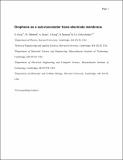| dc.contributor.author | Garaj, Slaven | |
| dc.contributor.author | Hubbard, William A | |
| dc.contributor.author | Reina, A. | |
| dc.contributor.author | Branton, Daniel | |
| dc.contributor.author | Golovchenko, Jene A. | |
| dc.date.accessioned | 2012-06-05T16:34:28Z | |
| dc.date.issued | 2010 | |
| dc.identifier.citation | Garaj, Slaven, William A. Hubbard, A. Reina, Daniel Branton, and Jene A. Golvchenko. 2010. Graphene as a sub-nanometer trans-electrode membrane. Nature 467(7312): 190-193. | en_US |
| dc.identifier.issn | 0028-0836 | en_US |
| dc.identifier.uri | http://nrs.harvard.edu/urn-3:HUL.InstRepos:8835475 | |
| dc.description.abstract | Isolated, atomically thin conducting membranes of graphite, called graphene, have recently been the subject of intense research with the hope that practical applications in fields ranging from electronics to energy science will emerge. The atomic thinness, stability and electrical sensitivity of graphene motivated us to investigate the potential use of graphene membranes and graphene nanopores to characterize single molecules of DNA in ionic solution. Here we show that when immersed in an ionic solution, a layer of graphene becomes a new electrochemical structure that we call a trans-electrode. The trans-electrode’s unique properties are the consequence of the atomic-scale proximity of its two opposing liquid–solid interfaces together with graphene’s well known in-plane conductivity. We show that several trans-electrode properties are revealed by ionic conductance measurements on a graphene membrane that separates two aqueous ionic solutions. Although our membranes are only one to two atomic layers thick, we find they are remarkable ionic insulators with a very small stable conductance that depends on the ion species in solution. Electrical measurements on graphene membranes in which a single nanopore has been drilled show that the membrane’s effective insulating thickness is less than one nanometre. This small effective thickness makes graphene an ideal substrate for very high resolution, high throughput nanopore-based single-molecule detectors. The sensitivity of graphene’s in-plane electronic conductivity to its immediate surface environment and trans-membrane solution potentials will offer new insights into atomic surface processes and sensor development opportunities. | en_US |
| dc.description.sponsorship | Engineering and Applied Sciences | en_US |
| dc.description.sponsorship | Molecular and Cellular Biology | en_US |
| dc.description.sponsorship | Physics | en_US |
| dc.language.iso | en_US | en_US |
| dc.publisher | Nature Publishing Group | en_US |
| dc.relation.isversionof | doi:10.1038/nature09379 | en_US |
| dc.relation.hasversion | http://arxiv.org/abs/1006.3518 | en_US |
| dash.license | OAP | |
| dc.title | Graphene as a Sub-Nanometer Trans-Electrode Membrane | en_US |
| dc.type | Journal Article | en_US |
| dc.description.version | Accepted Manuscript | en_US |
| dc.relation.journal | Nature | en_US |
| dash.depositing.author | Golovchenko, Jene A. | |
| dc.date.available | 2012-06-05T16:34:28Z | |
| dc.identifier.doi | 10.1038/nature09379 | * |
| dash.authorsordered | false | |
| dash.contributor.affiliated | Hubbard, William A | |
| dash.contributor.affiliated | Garaj, Slaven | |
| dash.contributor.affiliated | Branton, Daniel | |
| dash.contributor.affiliated | Golovchenko, Jene | |


